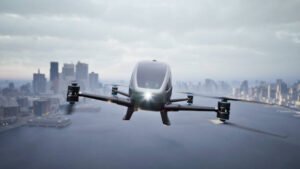India Set to Launch First Drone Taxi in Andhra Pradesh
|
General Studies Paper II: Scientific Innovations and Discoveries, Indigenization of Technology |
Why in News?
Recently, Andhra Pradesh announced a partnership deal with Karnataka-based Sarla Aviation to establish India’s first drone taxi ecosystem, marking a major step toward electric air mobility and futuristic urban transportation.

Highlights of Andhra Pradesh Drone Taxi Project
- Andhra Pradesh announced a partnership with Sarla Aviation on 17 November 2025. The state government and the company agreed to build a large manufacturing and testing ecosystem for electric air taxis.
- The project involves an initial investment of ₹1,300 crore to build a 500-acre “Sky Factory” in Anantapur district.
- The government described the facility as a giga-scale manufacturing cluster. The first phase will use about 150 acres and will involve a Phase-1 outlay of roughly ₹330 crore for land, basic infrastructure and a DGCA test runway.
- The second phase will expand the area by 350 acres, totaling ₹1,300 crore.
- The giga campus will host multiple specialised units. These will include composites and airframe lines, powertrain and battery assembly, avionics and embedded systems workshops, and wire harness and landing gear production.
- The complex will also include R&D labs, simulation centres, pilot training facilities, and maintenance repair and overhaul units except dedicated VTOL test pads and a runway for hybrid flight testing.
- Sarla Aviation set an ambition to scale manufacturing in stages and to target commercial air-taxi operations by 2029. The plan envisages ramping up to a capacity of about 1,000 aircraft per year once the campus reaches full scale.
What is a Drone Taxi?
-
- About: A drone taxi, also called an electric air taxi, is a small aircraft that lifts off and lands vertically using electric power. These vehicles belong to a class called eVTOL — electric Vertical Take-Off and Landing aircraft. These craft do not need long runways. They are designed for passenger transport, not just for cargo or surveillance.
- Drone taxis promise a way to reduce city traffic congestion. In India, where commuting time is very high, they could dramatically cut travel durations.
- About: A drone taxi, also called an electric air taxi, is a small aircraft that lifts off and lands vertically using electric power. These vehicles belong to a class called eVTOL — electric Vertical Take-Off and Landing aircraft. These craft do not need long runways. They are designed for passenger transport, not just for cargo or surveillance.
- Core Features:
-
- Vertical Take-Off and Landing (VTOL): Drone taxis use multiple rotors or propellers to lift off like a helicopter. Once in the air, they may transition to more efficient flight modes (in some designs) for forward travel.
- Electric Propulsion: They rely on electric motors powered by batteries. This makes them quieter and cleaner compared to fossil-fuel helicopters. Many designs emphasize distributed propulsion.
- Short-Range Urban Mobility: Drone taxis are meant for short city or regional trips. Most models can cover routes between 20 and 40 km.
- Lightweight Airframe: Manufacturers use carbon composites and other light materials. A lighter frame improves efficiency and increases payload capacity.
- Landing Points (“Vertiports”): These aircraft use special landing and take-off hubs called vertiports. Vertiports may be on rooftops, parking areas, or dedicated structures — not runways.
- Low Noise Signature: Electric rotors produce less noise than helicopters. Cities can allow these aircraft to operate near dense neighbourhoods. This feature supports wider adoption of air mobility.
- Smart Navigation Systems: A drone taxi carries sensors, cameras and radar systems. These tools help detect obstacles and follow safe air corridors. The vehicle uses real-time data to adjust flight paths.
- Digital Connectivity: A drone taxi connects to a central control system. Operators track flight routes, weather and traffic. This digital link supports safe fleet operations in busy airspace.
Features and Technical Details of the Shunya Flying Taxi
- About: Shunya is an Indian eVTOL designed by Sarla Aviation for short urban and regional hops. The vehicle aims to serve as a piloted air taxi to cut road travel time in congested cities. The prototype first appeared publicly in January 2025.
- Seating and cabin. The aircraft has a seven-seat layout with one pilot and six passengers. The cabin designers balanced comfort and weight to match urban mission profiles.
- Propulsion architecture. Shunya uses a distributed electric propulsion design made up of seven electric motors. The craft relies on multiple rotors to produce vertical lift and to give redundancy in flight.
- Power system and batteries. The vehicle runs on four double-isolated battery packs. The battery setup supports the motors and the onboard electrical systems. The battery management system monitors pack health.
- Speed and cruise performance. Shunya can reach a maximum cruise speed of about 250 km/h. The high cruise speed makes short city trips and airport transfers fast compared with surface travel.
- Range and mission profile. The aircraft’s maximum range is around 160 km under current battery technology. The vehicle is optimised for 20–30 km trips typical of intra-city commutes and near-city airport links.
- Payload and useful load. Shunya can carry a payload of about 680 kg. The payload figure covers passengers’ baggage and any additional mission equipment. This payload capability supports a full complement of six passengers plus pilot for typical urban missions.
- Safety and redundancy. The design includes multiple redundant systems for propulsion control, flight control and power distribution. The distributed rotor layout reduces the risk from single-point failures. The manufacturer also fits real-time monitoring.
- Operational support and charging. Shunya is meant to use compact vertiports and fast turnaround procedures. The concept includes rapid charging and modular battery swaps at landing hubs to enable frequent flights.
Significance of the Andhra Pradesh Drone Taxi Project
- India’s Advanced Air Mobility: This project places India among the early adopters of urban air mobility. Many countries like the US, Germany and China began large-scale eVTOL development after 2020. India’s entry signals that the country is moving into high-tech aviation domains instead of remaining only a consumer market.
- Aerospace Manufacturing Hub: The 500-acre giga-scale cluster in Anantapur builds a concentrated industrial zone for electric aircraft manufacturing. Such clusters strengthen domestic supply chains for batteries, motors, composites and avionics. This reduces import dependence and helps create a local aerospace ecosystem. It also opens opportunities for MSMEs and startups to work as Tier-1 and Tier-2 suppliers.
- Regional Economy & Job Creation: The project brings a planned investment of ₹1,300 crore, which will directly support manufacturing jobs, engineering roles and technical training. Indirect jobs will emerge in logistics, component supply, testing services and maintenance. Anantapur will gain new economic activity linked to high-tech industries.
- Urban Mobility Transformation: Drone taxis offer fast, short-distance travel and can reduce congestion on busy urban routes. Cities like Bengaluru, Hyderabad and Chennai face long commute times. This initiative accelerates India’s shift toward multi-layer mobility systems, combining roads, metro rail and aerial routes.
- Clean and Sustainable Transport: The project uses electric propulsion, which aligns with India’s climate goals for 2030 and beyond. These aircraft produce no tailpipe emissions and create less noise than helicopters. This project supports India’s broader renewable energy and EV ecosystem.
- National Transport Policy: The project helps India set early standards for drone traffic management, vertiport design, safety systems and certification frameworks and supports UDANA Scheme. As DGCA builds new regulations for air taxis, Andhra Pradesh’s project will serve as a national testbed. This creates long-term strategic capacity in planning future transport networks.
|
Company Sarla Aviation
|
|
Also Read: India’s First ‘Quantum Valley’ Tech Park |









